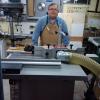I bought a couple of CGG Schmidt corrugated heads for my RS-15 based on recommendations from many of the good folks here. But before I can use them, I need to get the machine running. It came in working order from a shop using 460V, 3-ph. I need to run it on 230V, 3-ph. I'm good with general electrics, having completely wired 3 shops, 1 garage, and an apartment, but I'm a little out of my league when it comes to transformers. Here's what I've got...
The first pic shows the overall wiring in the cabinet. Power (from the plug) enters from the little black terminal on the lower left. The little red terminal goes to the power switch and kill switch. The upper right unit is a GE CR353XAAA Contactor. The lower right is an Impervitran B040-0026-5 Transformer. The heavier red/brown/black wires on the upper left of the photo go to the motor.
The second pic shows the right side of the transformer. The black wire with the red terminal connector is connected to H2, labeled 460V. H4 is labeled 230V. Part of me is hoping that rewiring this thing to run on 230V, 3-ph. is just as simple as moving that wire from H2 to H4. But my track history in the luck department says that there's more to it than that, and some other wires have to be moved around.
I just don't want to fry anything, so I thought I'd seek the advice of the knowledgeable motor gurus here. I should emphasize knowledgeable -- while I appreciate people just trying to help, if your electrical experience stops at changing a few outlets and lamp cords, then I'd rather you pass on this one.
Thanks!
Keith




 Reply With Quote
Reply With Quote



